Features
Kingdom Hearts Re:coded – The Best RPG No One Likes
Kingdom Hearts Re:coded won’t be anyone’s favorite game, but it might very well be the best RPG no one likes.
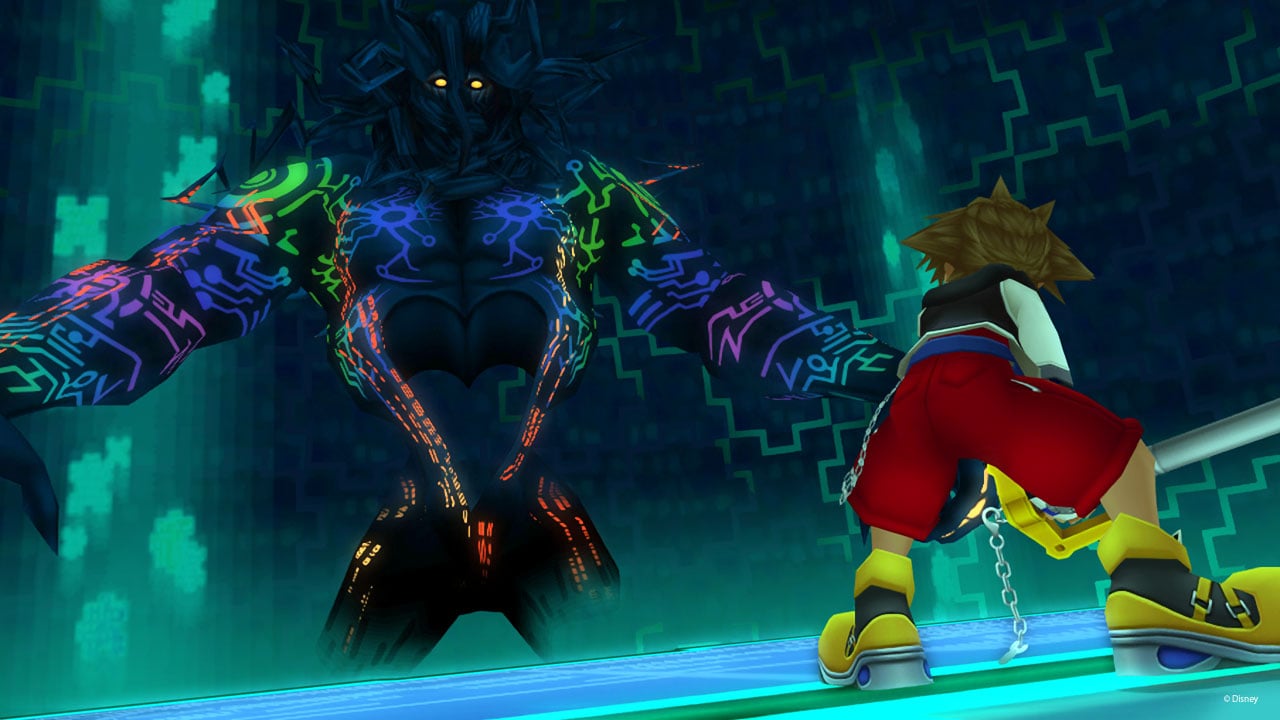
Revisiting Kingdom Hearts Re:coded
Kingdom Hearts made a bold statement with Chain of Memories in 2004: there are no spin-offs. Despite being a GBA follow up to a PS2 game with completely different combat, Chain of Memories served as an immediate & important direct sequel to the events of the first game– one necessary to play in order to understand everything in Kingdom Hearts II with as much clarity as possible. Audiences may have placed down their Keyblade for a pack of playing cards, but Chain of Memories stayed true to the Kingdom Hearts experience. It’s different enough in design where one might consider it a spin-off, but not so detached from the first game where it feels inconsequential, filler, or just out of place. CoM filled an important narrative gap that needed filling.
This set up a trend for the series’ non-numbered installments. Chain of Memories, 356/2 Days, and Birth by Sleep are all unique games that would be spin-offs in any other franchise, but they’re essential to not just understanding Kingdom Hearts’ narrative, but appreciating the scope of the series’ game design. Both Chain of Memories and 356/2 Days lift quite a lot from Kingdom Hearts I and II, but to call either one derivative would simply be a lie. There is value in revisiting familiar set pieces and recontextualizing events from the first two games, but audiences can only stomach the same content so many times before they sour on it.
At times seeming like a cheap imitation of Kingdom Hearts I, Re:coded is stuck between its great mechanical contributions to the series and falling at a very awkward point in the franchise’s release timeline. Despite releasing the same year as Birth by Sleep (just 10 months later in October of 2010,) Re:coded is actually a remake of the fourth Kingdom Hearts title, the Japanese and mobile phone exclusive, Kingdom Hearts coded. Released episodically between November 2008 and January 2010, coded was initially developed as a more naturalistic title– one that could exist outside the confines of the series as a legitimate spin-off.

This, in part, explains both Re:coded’s strange implementation of gimmicks and seemingly inconsequential story. coded wasn’t meant to be an essential part of the Kingdom Hearts mythos, but this of course changed along the way. Set chronologically after the events of Kingdom Hearts II, Re:coded’s story begins with Jiminy Cricket & King Mickey creating a digitized version of Sora to uncover the secrets behind a mysterious message that suddenly appeared in the journal Jiminy chronicled the events of the first game in.
Some quick context and recapping: Chain of Memories ends with everything in Jiminy’s journal erased along with the main cast’s memories. All they have left to remember what happened in CoM is a single message in the journal that reads, “Thank Namine.” This becomes a rallying call of sorts for Sora in Kingdom Hearts II, but it’s otherwise left unexplained to the main cast, with only the audience understanding the full scope of Namine’s relationship with Sora. It’s a plot point that always called for more resolution than KH II gave it, but to dedicate an entire game to resolving it?
Of course, this makes sense when remembering that coded was originally an episodic cell phone game that was released over the course of two years. It wasn’t an entire game. It was bits and pieces of a larger product that, in the grand scheme of things, actually was a spin-off. Until it wasn’t. Around halfway through coded/Re:coded, the plot disconnects itself hard from the original premise, with series antagonists Maleficent and Pete now actively hindering Data-Sora’s progress inside the journal. Namine’s message is momentarily pushed to the side while a digitized version of Riku starts driving the story along.
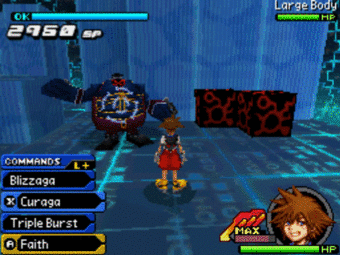
Although Data-Riku’s introduction ultimately helps salvage what little narrative worth there is in Re:coded’s plot, but it directly shines a spotlight on how poorly told the story is. It isn’t enough that the story is often disjointed, likely stemming from its episodic origins, but the presentation is god awful. While 358/2 Days couldn’t get much facial expression out of character models, in-game cutscenes were at least well directed and featured varied, sensible cinematography. Re:coded opts for static cutscenes where character models are slapped on-screen with comic book-esque dialogue boxes.
This does allow for character models to be much more expressive, but Re:coded doesn’t take advantage of this, opting to reuse the same few poses amongst characters. Worse yet, it’s so much harder to immerse in what’s an already boring story when information is presented in such a bland way. Kingdom Hearts is better written than most give it credit for, but its strength in writing comes from how it approaches character arcs and themes. When the base plot centers on a character who is a carbon copy of the protagonist at his least developed and the main plot is crudely divided into two halves, the story’s presentation needs to be damn good. Which it is not.
A bad story can be enough to kill a game in a series as narrative-driven like Kingdom Hearts, but as bad as Re:coded’s story is, Kingdom Hearts is a video game franchise first and foremost. One that tends to make good use of unique gameplay in the non-numbered entries. Re:coded’s story is bad– no two ways about it– but the gameplay makes some fantastic improvements on Birth by Sleep’s Command System and core combat.
Although Re:coded inherits coded’s story as-is (albeit with some additions,) combat has been revised to not only better suit the Nintendo DS, but what’s to be expected from the series’ gameplay. Data-Sora doesn’t live up to his namesake in terms of personality, but he’s an incredibly fun character to control– probably the best of the non-numbered protagonists. The Command Matrix allows Data-Sora to equip different commands that he can use in battle, ranging from physical techniques to magic. Rather than being exhausted after use, commands recharge on a timer, allowing players to craft a command system that suits their play style.
Better yet, commands can actually be combined with each other. On the Command Matrix, players can equip a sub-command that’ll either buff the equipped command or change it outright. Compatible commands are marked with a yellow glow, and once both equipped commands are leveled, players can actually permanently fuse them together in order to make new techniques. The Command Matrix rewards an incredible amount of creativity and exploration. As commands are often dropped by enemies and granted as rewards, diligent players will find themselves working with a large variety of techniques over the course of the game.
Keyblades improve combat even further, with each one having a “Clock Ability Tree” that buffs Data-Sora during battle. By attacking enemies and using commands, the clock gauge will fill up over the course of 4 levels, each one representing a different tier in the Keyblade. Tiers also branch out, allowing players to customize their Keyblade’s progression during battle. As each new tier offers new effects (such as an auto-counter or just adding elemental properties to attacks,) battles rarely feel static thanks to how dynamic the Keyblade can be. Branching paths among tiers also add for some nice customization, ensuring early game Keyblades can still have some sort of play later on– to say nothing of how unique each Keyblade plays.
As nice as the Command Matrix and Keyblades are, the Stat Matrix is what ultimately steals the show. Essentially a digital version of Final Fantasy X’s Sphere Grid, players place down chips with unique attributes into predetermined slots onto the Stat Matrix in order to buff Data-Sora. While the Stat Matrix is initially limited, it gradually expands over the course of the game. Not just that, there are multiple roadblocks in the Matrix that can only be bypassed with rare items. There will eventually come a point where players will need to pick a path and stick to it, but it’s this decision making that makes the Stat Matrix so engaging.
With dozens of chips to place down (from Level Up chips to elemental resistance,) the Stat Matrix: levels Data-Sora up, buffs his stats, grants him new abilities, unlocks new command slots, unlocks new accessory slots, and allows players to access build-in cheats that greatly affect how the game is played. Connecting two CPU slots through a line of chips will actually double the effects of all the chips between the CPUs, but players might be eager to connect to the Cheat Tuners before hunting down CPUs. With five Cheat Tuners to play with, Re:coded offers a considerable amount of freedom when it comes to progression.
Cheat Tuners essentially allow you to fundamentally change how Re:coded is played at any time. The Cheat Tuner gives access to all four difficulty modes right away (Beginner, Normal, Hard, and Critical) with no consequence for switching between the four, but the Loot, Prize, CP, and HP Cheats can lead to some insane gameplay scenarios. The Loot Cheat increases the drop rate at the expense of lowering Data-Sora’s health; the Price Cheat spawns prizes more often, but enemies are much stronger; the CP Cheat speeds up the leveling process for commands while chipping away at Data-Sora’s personal EXP; and the HP Cheat can drop everyone’s health down to 1 HP. This is a level of freedom RPGs rarely ever allow, but it’s very much welcome.
With such amazing gameplay concepts, it seems almost silly anyone would dislike Re:coded, doesn’t it? The story is lousy, sure, but Kingdom Hearts is more than its narrative. These are video games and what matters most is a video game engaging its audience in a way that’s both entertaining and meaningful. Re:coded might not have much in the way of meaning, but it’s certainly very entertaining. Or it would be if this were the whole story. Kingdom Hearts may be more than its narrative, but it’s also more than its gameplay– and good gameplay is nothing without good game design.
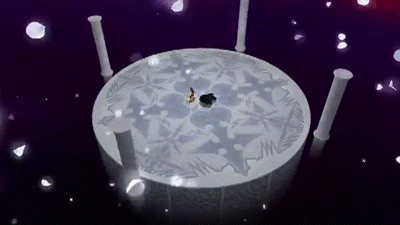
The first thing anyone familiar with Kingdom Hearts will notice is how every single world except for the last is lifted from the first game. Chain of Memories did this as well (as did 358/2 Days to an extent,) but Re:coded pushes the limits of how often the series can go back to the first game’s well. It’s dry now and it was arguably dry by the end of Chain of Memories. Still, reused assets aren’t inherently bad and they can be recontextualized in interesting ways.
At first glance, it looks like this will be exactly what Re:coded does. Every world Data-Sora visits is littered with bugs that he has to debug and, to their credit, each world does feature a unique story unlike that of the first game’s or Chain of Memories. Unfortunately, this isn’t all that’s unique each world brings with it. For as good as the core gameplay is, it’s constantly battled by mini-games that outright replace bosses in almost every single world. Excited to use those commands against Traverse Town’s boss? Think again, the game is now an auto-scrolling platformer. Want to tear into Trickmaster? Wonderland’s finale is an auto-runner ala Space Harrier.
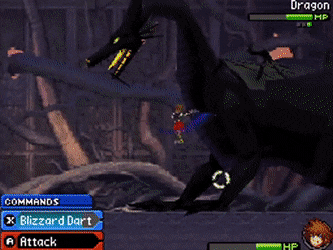
The worst offender is a 2D side-scrolling boss fight against Maleficent near the end of the game. Kingdom Hearts is a series that consistently does boss fights well, but Re:coded drops the ball horrifically, making incredibly poor use of its Command Matrix for the majority of the game. It’s certainly fun using commands against regular Heartless, but the lack of boss fights over the course of the playthrough essentially makes a promise that anyone just looking to beat the game will come out completely and wholly unsatisfied.
What’s worse is that the world design would actually be great without all the gimmicks overshadowing everyone. Worlds feature a decent bit of platforming again, but they’re not handled nearly as poorly as they were in Kingdom Hearts I. There aren’t many secrets to uncover, but there are secrets to uncover. Throw in the ability to replay any world (with its story intact) and it’s hard not to feel like everything is present for a great game. Yet the pieces don’t click together as well as they should given how poorly the game presents itself. In no world should a Kingdom Hearts game throw away entire boss fights in favor of mini-games that neither make use of the core mechanics or challenge a player’s skill.
When it comes down to it, does it really matter that Re:coded has such great gameplay when it has the worst game design in the franchise? General consensus seems to be that Re:coded is the better game while 358/2 Days tells a better story, as far as the DS entries go, but this reading ignores how each game uses its design & combat. Despite Re:coded having fluid combat with plenty of room for both customization & variety, the level, and boss design are at odds with what Data-Sora can accomplish in battle, often stripping away his abilities in favor of mini-games.
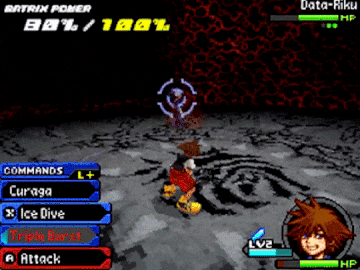
Days is a very slow game, but it’s one by design, where its most tedious quirks at least have some deliberation in their placement. Roxas being deleveled for a single mission adds sudden gameplay tension while highlighting an important day in Roxas’ character arc. Data-Sora being deleveled for an entire chunk of gameplay while players are forced to revisit Worlds they’ve already cleared is jarring, frustrating, and just plain not fun. Both these instances occur near the end of their respective stories, but Days has the decency to confine it to a few minutes. Re:coded delevels Data-Sora for a few hours.
Re:coded’s overreliance on gimmicks might stem from its roots as a cell phone game, but if the core combat could change so much, so should have the mini-games. The moment the Command Matrix was conceived, mini-games should have been thrown out the door. All they do is distract from a genuinely great RPG, forcing walls in an addictive gameplay loop. Kingdom Hearts struck gold with Re:coded’s combat only to bury it back into the ground every few hours. No self-respecting action RPG should replace boss fights with mini-games. Once for variety, maybe, but for almost every boss in the game? That’s just cruel.
To its credit, Re:coded does end on a very high note– both narratively and gameplay-wise. It’s not enough to excuse how poorly designed the majority (and it really is the majority) of the game is, but it’s enough to make you forget. A digitized version of Castle Oblivion from Chain of Memories serves as the final world and, interestingly, Data-Sora has all his memories erased before the finale. While some might question the value in wiping a blank slate main character clean, Data-Sora’s freshly lost memories allow for the antagonist to wax poetic about the real Sora’s nature in a way that’s actually meaningful.
Kingdom Hearts Re:coded won’t be anyone’s favorite game, but it might very well be the best RPG no one likes.
These last few moments may star Data-Sora, but they’re all about dissecting what makes Sora who he is. It’s a nice bit of pathos tucked away at the very end of the game, but it’s enough to remind fans of the series why they stuck with Kingdom Hearts in the first place. At its best, it’s a story that intimately understands its characters, their motivations, and their relationship to the world around them. Often wordy and silly, but emotionally nuanced all things considered. If the entire game were framed around giving the audience a better sense of Sora’s person rather than the sloppy mystery angle, Re:coded could have wound up with one of the series’ better stories.
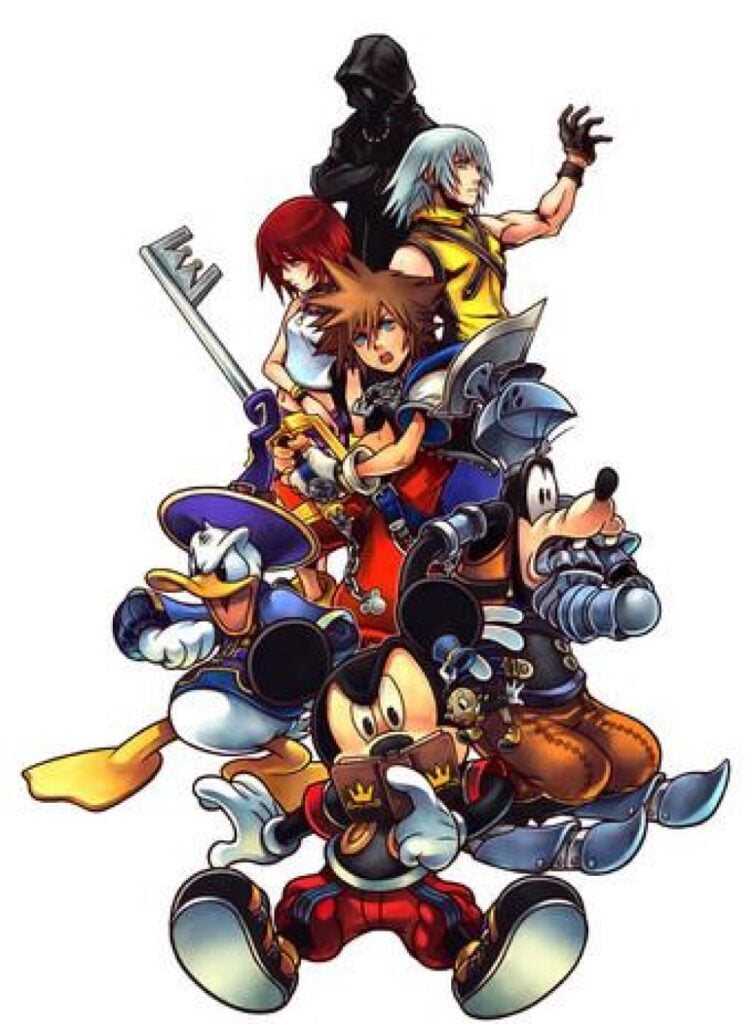
Same case for the gameplay. Without those gimmicky mini-games, Re:coded plays amazingly, which is something Castle Oblivion recognizes. The only gimmick here is that players can do whatever they want. Using a set of world cards to revisit altered versions of each stage in the game, Castle Oblivion recontextualizes the entire journey up to this point into something so much more. Everything has been building up to this. Data-Sora is confronted with familiar scenarios, but the nature of Castle Oblivion allows means worlds can be solved one of three ways, all based on how players interact with each world.
Want to kill some NPCs? Go for it, they’re just data. In a rush to beat the game? Fail the objective. Unhappy with how the world’s ending played out? Try again and come to another conclusion. This is a level of in-game variety on par with the Command and Stat Matrix. Castle Oblivion is the only part of Re:coded where every facet of the game’s design lines up cohesively. Considering it comes after hours of learning to love a combat system you aren’t allowed to use to its fullest, it’s really no wonder most people don’t like Re:coded.
It might sound contradictory after all this, but Kingdom Hearts Re:coded is still worth playing. By hardcore fans, or anyone who doesn’t care about the story just looking for a good action RPG for their DS. As mind-numbing as those mini-games are, they do come to an end eventually, and Castle Oblivion is just a fantastic video game level from start to finish. This does mean suffering through content that just isn’t that fun to play through, but at the core of the experience is an incredibly fun action RPG with plenty of variety to go around. Rarely is such a good game surrounded by so much mediocrity, but sometimes it’s worth slogging through lesser content to get to something truly good. Kingdom Hearts Re:coded won’t be anyone’s favorite game, but it might very well be the best RPG no one likes.

-

 Features4 weeks ago
Features4 weeks agoGet Ready: A Top Isekai Anime from the 2020s Is Headed to Hulu!
-

 Features4 weeks ago
Features4 weeks agoSocial Gaming Venues and the Gamification of Leisure – A New Era of Play
-

 Features4 weeks ago
Features4 weeks agoSolo Leveling Snubbed?! You Won’t Believe Who Won First at the 2025 Crunchyroll Anime Awards!
-

 Culture4 weeks ago
Culture4 weeks agoThe Global Language of Football: Building Community Beyond Borders
-

 Technology2 weeks ago
Technology2 weeks agoGamification and Productivity: What Games Can Teach SaaS Tools
-

 Features2 weeks ago
Features2 weeks agoThis Upcoming Romance Anime Might Just Break the Internet; Trailer Just Dropped!
-

 Features4 days ago
Features4 days agoDon’t Watch These 5 Fantasy Anime… Unless You Want to Be Obsessed
-

 Features2 weeks ago
Features2 weeks agoFarewell to a Beloved 13-Year-Old Isekai Anime That Brought Us Endless Laughter
-

 Features3 weeks ago
Features3 weeks agoWait, What?! Tom & Jerry Just Turned Into an Anime and It’s Glorious!
-

 Culture2 weeks ago
Culture2 weeks agoIs the Gaming Industry Killing Gaming Parties?
-

 Guides3 weeks ago
Guides3 weeks agoHow to Earn and Spend Diamonds in Mobile Legends
-

 Game Reviews2 weeks ago
Game Reviews2 weeks agoCall of Duty and the Myth of Military Realism: Tactical or Just Tacticool?




